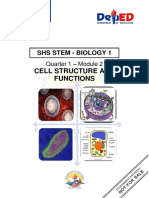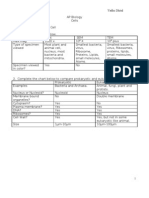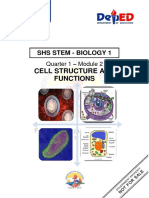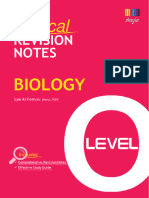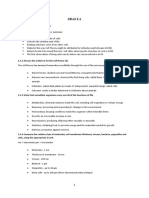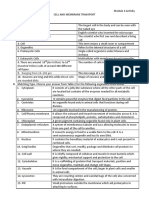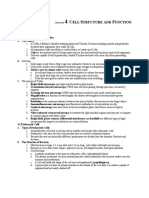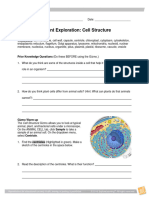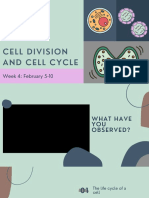Chapter 7 Study Guide
Chapter 7 Study Guide
Uploaded by
NihalAbou-GhalyCopyright:
Available Formats
Chapter 7 Study Guide
Chapter 7 Study Guide
Uploaded by
NihalAbou-GhalyCopyright
Available Formats
Share this document
Did you find this document useful?
Is this content inappropriate?
Copyright:
Available Formats
Chapter 7 Study Guide
Chapter 7 Study Guide
Uploaded by
NihalAbou-GhalyCopyright:
Available Formats
Name Date Class
CHAPTER 7
Study Guide
Section 1: Cell Discovery and Theory
In your textbook, read about the history of the cell theory and microscope technology.
Respond to each statement.
1. Name the invention that helped scientists discover the cell.
2. Tell why Hooke called the structures he saw in the cork cellulae (“small rooms”).
3. Name the type of microscope that uses a series of magnifying lenses.
Write the term or phrase that best completes each statement. Use these choices:
cell theory cells daughter cells genetic material organisms
The (4) includes the following three principles:
1. All living organisms are composed of one or more (5) .
2. Cells are the basic unit of structure and organization of all living
(6) .
3. Cells arise only from previously existing cells, with cells passing copies of their
(7) on to their (8) .
In your textbook, read about basic cell types.
Complete the table by checking the correct column(s) for each description.
Description Prokaryotes Eukaryotes
9. Organisms that break down molecules to generate energy
10. Organisms that have cells lacking internal membrane-bound organelles
11. Organisms whose cells do not have nuclei
12. Organisms that are either unicellular or multicellular
13. Organisms that are generally unicellular
14. Organisms that have cells containing organelles
15. Organisms that have plasma membranes
Unit 2 CHAPTER 7 Cellular Structure and Function 51
Name Date Class
CHAPTER 7
Study Guide Section 2: The Plasma Membrane
In your textbook, read about the function of the plasma membrane.
Complete the table by checking the correct column(s) for each description.
Selective Plasma
Description Homeostasis
Permeability Membrane
1. The process of maintaining balance inside a cell
2. A boundary between a cell and its environment
3. The feature of the plasma membrane that keeps
some substances out
4. Separates prokaryotic and eukaryotic cells from
the watery environment in which they exist
5. The quality of a plasma membrane that allows
oxygen and glucose to move in
6. Maintained by the plasma membrane
In your textbook, read about the structure of the plasma membrane.
Label the diagram of the plasma membrane. Use these choices:
carbohydrate chain nonpolar tails polar head transport protein
7.
8.
9.
10.
Match the definition or description in Column A with the term in Column B.
Column A Column B
11. make up most of the molecules in the plasma membrane A. transport proteins
12. a molecule that has a glycerol backbone, two fatty acid B. lipids
chains, and a phosphate-containing compound
C. phospholipid
13. move substances through the plasma membrane
D. fluid mosaic model
14. two layers of phospholipids arranged tail-to-tail
E. phospholipid bilayer
15. the phospholipid “sea” in which embedded substances float
52 Cellular Structure and Function CHAPTER 7 Unit 2
Name Date Class
CHAPTER 7
Study Guide Section 3: Structures and Organelles
In your textbook, read about structures and organelles.
Label the diagram of a typical animal cell. Use these choices:
cytoplasm endoplasmic reticulum Golgi apparatus microtubules
mitochondrion nucleolus nucleus
1.
2.
3.
4.
5.
6.
7.
If the statement is true, write true. If the statement is false,
replace the italicized word or phrase to make it true.
8. Microtubules are long, hollow protein cylinders that form a rigid skeleton for
the cell.
9. The Golgi apparatus contains most of the cell’s DNA.
10. The nucleolus is the structure that produces sugars.
11. The endoplasmic reticulum is a stack of membranes that packages proteins into
sacs called vesicles.
12. The cytoplasm is the semifluid internal environment of the cell.
Unit 2 CHAPTER 7 Cellular Structure and Function 53
Name Date Class
CHAPTER 7
Study Guide Section 4: Cellular Transport
In your textbook, read about cellular transport.
Match the definition in Column A with the term in Column B.
Column A
Column B
1. moves small molecules across the plasma membrane
using transport proteins A. osmosis
2. involves water moving across the plasma membrane B. exocytosis
to the side with the greater solute concentration
C. facilitated diffusion
3. occurs when substances move against the concentration
gradient; requires energy and the aid of carrier proteins D. dynamic equilibrium
4. occurs when the plasma membrane surrounds a large E. active transport
substance inside the cell and moves it outside the cell
F. endocytosis
5. the condition that results when diffusion continues until
the concentrations are the same in all areas
6. occurs when the plasma membrane surrounds a large
substance outside the cell and moves it inside the cell
In your textbook, read about osmosis.
Complete the table by checking the correct column(s) for each description.
Isotonic Hypotonic Hypertonic
Description Solution Solution Solution
7. A solution that has the same osmotic concentration as a
cell’s cytoplasm
8. A solution that causes a cell to shrivel
9. A solution that causes a cell to swell
10. A solution that neither shrinks nor swells a cell
11. A solution in which there is more water outside the cell than
inside the cell
12. A solution that causes water to move out of a cell
54 Cellular Structure and Function CHAPTER 7 Unit 2
You might also like
- The American Republic To 1877Document54 pagesThe American Republic To 1877NihalAbou-Ghaly67% (3)
- DR - John Chung 15 Math Tests S PDFDocument420 pagesDR - John Chung 15 Math Tests S PDFNihalAbou-Ghaly0% (2)
- DR - John Chung 15 Math Tests S PDFDocument420 pagesDR - John Chung 15 Math Tests S PDFNihalAbou-Ghaly0% (2)
- Lab Manual - Cells - A+p - StudentDocument24 pagesLab Manual - Cells - A+p - StudentsylNo ratings yet
- Study Guide and Intervention WorkbookDocument184 pagesStudy Guide and Intervention WorkbookIshneet Dhillon100% (14)
- Worksheet No. 1 - Cell OrganelleDocument3 pagesWorksheet No. 1 - Cell OrganelleLaureen BarbsNo ratings yet
- CH 7 Study GuideDocument4 pagesCH 7 Study Guideapi-342334216100% (1)
- SHS STEM Bio1 Q1 Week 1 Module 2 - Cell Structure And-FunctionsDocument23 pagesSHS STEM Bio1 Q1 Week 1 Module 2 - Cell Structure And-FunctionsEmer Perez50% (2)
- College Essay Writer's Lab WorkbookDocument44 pagesCollege Essay Writer's Lab WorkbookNihalAbou-GhalyNo ratings yet
- AssetDocument54 pagesAssetNihalAbou-Ghaly100% (2)
- Aops TocDocument12 pagesAops TocNihalAbou-Ghaly25% (8)
- APIADOP ANA PHY Lab Activity 2 The Function of Composite CellDocument4 pagesAPIADOP ANA PHY Lab Activity 2 The Function of Composite CellAj ApiadoNo ratings yet
- Honors Biology II Cells Study Guide BDocument12 pagesHonors Biology II Cells Study Guide BRiham Al-kholyNo ratings yet
- Gen Bio 1Document6 pagesGen Bio 1Isle Nysst RazonNo ratings yet
- Cells Questions and VocabDocument12 pagesCells Questions and VocabFanna Sharma100% (1)
- Act2 Bio SciDocument4 pagesAct2 Bio SciPamaran, Kristel DenishNo ratings yet
- SHS STEM Bio1 Q1 Week 1 Module 2 Cell Structure and Functions 1Document17 pagesSHS STEM Bio1 Q1 Week 1 Module 2 Cell Structure and Functions 1Dette Dominic Ballano67% (3)
- Campbell Biology 12e - U2 - Ch06 A Tour of the Cell -34Document1 pageCampbell Biology 12e - U2 - Ch06 A Tour of the Cell -34hassanmattar015No ratings yet
- Cells HW PacketDocument11 pagesCells HW PacketSandy Tana100% (2)
- Review Workshop 5THDocument5 pagesReview Workshop 5THjairo gomezNo ratings yet
- Topical Revision Notes Biology O LevelDocument140 pagesTopical Revision Notes Biology O Levelliyawee5No ratings yet
- Cell Organelles 2Document13 pagesCell Organelles 2Sadeeq ur RahmanNo ratings yet
- Worksheet 2 Cell StructureDocument4 pagesWorksheet 2 Cell StructurenathanNo ratings yet
- CELLS 2.1: Outline: To Give A Brief Account or SummaryDocument10 pagesCELLS 2.1: Outline: To Give A Brief Account or SummaryHrithik SolaniNo ratings yet
- Grade - 7 - Notes - Cells1112131 - 230929 - 081601 3Document7 pagesGrade - 7 - Notes - Cells1112131 - 230929 - 081601 3arshiyaworldinNo ratings yet
- My Answer in Our LaboratoryDocument4 pagesMy Answer in Our LaboratoryKris Marie DelaCruz DomingoNo ratings yet
- Cell Structure Worksheet 1 Bloom TaxonomyDocument4 pagesCell Structure Worksheet 1 Bloom Taxonomy[team nothing] ConvexNo ratings yet
- Lesson Guide: Science 7Document8 pagesLesson Guide: Science 7Bryan LigsayNo ratings yet
- Class_9_FUNDAMENTAL_UNIT_OF_LIFE_PART_C___D_1626364215Document9 pagesClass_9_FUNDAMENTAL_UNIT_OF_LIFE_PART_C___D_1626364215madhanadhi7No ratings yet
- The Fundamental Unit of Life: 1. Ncert Intext QuestionsDocument9 pagesThe Fundamental Unit of Life: 1. Ncert Intext QuestionsKumar AbhishantNo ratings yet
- Class 9 CH 5 and 6 Science PDFDocument52 pagesClass 9 CH 5 and 6 Science PDFananyatanwar001No ratings yet
- Exercise 1 The Cell 1Document6 pagesExercise 1 The Cell 1MJMadlangbayan100% (1)
- 4) Cell MembraneDocument17 pages4) Cell Membranescobi doNo ratings yet
- Ranging From 10-100 M: Blood Cells Are Rounded DisksDocument9 pagesRanging From 10-100 M: Blood Cells Are Rounded DisksJanine LimjucoNo ratings yet
- Cell MembraneDocument21 pagesCell Membranegenesisxr01No ratings yet
- I. Multiple Choice. Choose The Letter of The Best AnswerDocument3 pagesI. Multiple Choice. Choose The Letter of The Best AnswerKeannoNo ratings yet
- Lesson 2: Cell Types and Cell ModificationDocument14 pagesLesson 2: Cell Types and Cell ModificationMariz GenandaNo ratings yet
- LabEx4 - Eukaryotic CellDocument7 pagesLabEx4 - Eukaryotic CellLEAH VENICE CANSONNo ratings yet
- Biology WB Chap 5 and 6Document19 pagesBiology WB Chap 5 and 6bhagyashreemenden105No ratings yet
- Cell Organelle Review Worksheet Summer ValliniDocument3 pagesCell Organelle Review Worksheet Summer ValliniSummer ValliniNo ratings yet
- Taller 1 (Ingles)Document4 pagesTaller 1 (Ingles)Laura Avila BarreraNo ratings yet
- Topical Revision Notes Biology O LevelDocument86 pagesTopical Revision Notes Biology O Levelzendawayne632No ratings yet
- O Level Biology627Document175 pagesO Level Biology627Man MUBITANo ratings yet
- Chapter 2 Unit 2.1 and 2.3 WorksheetDocument6 pagesChapter 2 Unit 2.1 and 2.3 Worksheetmaariamshamsi2No ratings yet
- Biotech._Q1_Wk2Document14 pagesBiotech._Q1_Wk2RHODA FEDERENo ratings yet
- Ariana Moncayo - Ch-7-Guided-Reading - Doc.kamiDocument4 pagesAriana Moncayo - Ch-7-Guided-Reading - Doc.kamis252029No ratings yet
- Grade 11 FinalDocument16 pagesGrade 11 FinalAbdi Fettah AhmedNo ratings yet
- Marieb - CH - 03 - Lecture - Doc (Edited)Document9 pagesMarieb - CH - 03 - Lecture - Doc (Edited)Dustin RamosNo ratings yet
- Grade 9 Science Academic Vocabulary - Formula Term 1 AY - 23-24Document9 pagesGrade 9 Science Academic Vocabulary - Formula Term 1 AY - 23-24Suzan.FilizNo ratings yet
- GRADE 9 SLK-Week-7Document17 pagesGRADE 9 SLK-Week-7MilagrosBautistaNo ratings yet
- Chapter Outline: ELL Tructure and UnctionDocument5 pagesChapter Outline: ELL Tructure and Unctionrommel benamir100% (1)
- Cell (Lesson Plan)Document4 pagesCell (Lesson Plan)aiza.coltamaiNo ratings yet
- Fundamental Unit of Life Class 9 WsDocument2 pagesFundamental Unit of Life Class 9 WsKshiti HNo ratings yet
- Biology 12 - The Cell - REVIEW WORKSHEET: Name: Block: DateDocument4 pagesBiology 12 - The Cell - REVIEW WORKSHEET: Name: Block: DateMarianne Kristine RayalaNo ratings yet
- Cell - The Unit of LifeDocument7 pagesCell - The Unit of LifeAnkan GhoshNo ratings yet
- Kami Export - Aubrianna Labonte-Postell - CellStructure GizmoDocument5 pagesKami Export - Aubrianna Labonte-Postell - CellStructure Gizmoaubrianna.postellNo ratings yet
- Chapter 6 Tour of The CellDocument13 pagesChapter 6 Tour of The CellAstrii LyNo ratings yet
- NUÑEZ Cell Structure and Function 2022Document4 pagesNUÑEZ Cell Structure and Function 2022Kian S. NuñezNo ratings yet
- I. Cell StructureDocument5 pagesI. Cell StructureAllyson CarlosNo ratings yet
- CellStructureSE LandonsmithDocument5 pagesCellStructureSE LandonsmithLandon SmithNo ratings yet
- HISTOLOGY LaboratoryDocument5 pagesHISTOLOGY LaboratoryFarida GuialelNo ratings yet
- Questions For Chapter 2 BioDocument3 pagesQuestions For Chapter 2 Bio3bdallah.mseNo ratings yet
- FOLIO: Biology Form 4 Chapter 2: Cell Structure and OrganisationDocument51 pagesFOLIO: Biology Form 4 Chapter 2: Cell Structure and OrganisationSashimi 刺身 Chebby100% (1)
- Lab ActivityDocument7 pagesLab ActivityBummie xxxNo ratings yet
- Rajeem Outlaw Wright - Cell Organelle Review WorksheetDocument3 pagesRajeem Outlaw Wright - Cell Organelle Review WorksheetRajeem Outlaw WrightNo ratings yet
- Anatomy and Physiology: The Cell and Cell Division: Things You Should Know (Questions and Answers)From EverandAnatomy and Physiology: The Cell and Cell Division: Things You Should Know (Questions and Answers)No ratings yet
- Geometry Honors: 5.1 - 5.2 Practice: Find The Value of Each VariableDocument7 pagesGeometry Honors: 5.1 - 5.2 Practice: Find The Value of Each VariableNihalAbou-GhalyNo ratings yet
- Summer 2020 AMSCO Assignment Pt. 1 SasDocument10 pagesSummer 2020 AMSCO Assignment Pt. 1 SasNihalAbou-GhalyNo ratings yet
- 34 - 3 Study Guide Excretory SystemDocument1 page34 - 3 Study Guide Excretory SystemNihalAbou-GhalyNo ratings yet
- Solution:: P: 5 - 3 Q: All Vertical Angles Are Congruent. R: If 4x 36, Then X 9Document5 pagesSolution:: P: 5 - 3 Q: All Vertical Angles Are Congruent. R: If 4x 36, Then X 9NihalAbou-GhalyNo ratings yet
- Chap03 (1) With Answers PDFDocument76 pagesChap03 (1) With Answers PDFNihalAbou-GhalyNo ratings yet
- U4 TRPT 1Document6 pagesU4 TRPT 1NihalAbou-GhalyNo ratings yet
- Periodic Table Trends Worksheet - AnswersDocument3 pagesPeriodic Table Trends Worksheet - AnswersNihalAbou-Ghaly100% (1)
- Al Arabi Bin Yadik 1 B PDFDocument284 pagesAl Arabi Bin Yadik 1 B PDFNihalAbou-Ghaly100% (1)
- Ageless Apples (Reaction Rates & Catalysts)Document5 pagesAgeless Apples (Reaction Rates & Catalysts)NihalAbou-GhalyNo ratings yet
- Opinion Words and Phrases PDFDocument1 pageOpinion Words and Phrases PDFNihalAbou-Ghaly100% (1)
- 30 Day Doodle Challenge: Share Your Art WithDocument1 page30 Day Doodle Challenge: Share Your Art WithNihalAbou-GhalyNo ratings yet
- Cell Structure and FunctionDocument4 pagesCell Structure and FunctionAngeelina AgarwalNo ratings yet
- Lesson Plan Plant and Animal CellDocument4 pagesLesson Plan Plant and Animal CellOdessa De GuiaNo ratings yet
- General Biology I: CELL CITY PROJECT - You Are The ArchitectDocument4 pagesGeneral Biology I: CELL CITY PROJECT - You Are The ArchitectJorn Xyronn JavierNo ratings yet
- 1395631898ultrastructure of LysosomeDocument16 pages1395631898ultrastructure of LysosomeH KNo ratings yet
- Science 8 Quarter 4 Shortened Module 2 CELL DIVISION Week 2Document6 pagesScience 8 Quarter 4 Shortened Module 2 CELL DIVISION Week 2Alvin OliverosNo ratings yet
- Botany LAB Plant and Animal CellsDocument7 pagesBotany LAB Plant and Animal CellsJasmine SandroNo ratings yet
- Locomotion in ProtozoaDocument14 pagesLocomotion in ProtozoaSneha Sharma100% (2)
- Cyto Trans 2Document4 pagesCyto Trans 2erikamayranoa14No ratings yet
- Cell Division and Cell CycleDocument25 pagesCell Division and Cell CycleZamantha Zaynn100% (1)
- Cell Organelles - Notes Cell Theory Cells Are The Basic Unit of Life. The Cell Theory States ThatDocument7 pagesCell Organelles - Notes Cell Theory Cells Are The Basic Unit of Life. The Cell Theory States ThatSpongie BobNo ratings yet
- Cell Organelles and Their Functions - RS' ScienceDocument1 pageCell Organelles and Their Functions - RS' ScienceMishaNo ratings yet
- The Living Cell 1 PDFDocument15 pagesThe Living Cell 1 PDFNicole LamNo ratings yet
- 1.2. Cell Structure and Organisation PMTDocument3 pages1.2. Cell Structure and Organisation PMTJamesNo ratings yet
- IGCSE - CellDocument4 pagesIGCSE - CellSamer AwwadNo ratings yet
- Class 9 Bio NewDocument4 pagesClass 9 Bio NewAshim KarjeeNo ratings yet
- CellDocument27 pagesCellTom Anthony TonguiaNo ratings yet
- Lesson 2: Cell Organelles: Prepared By: Robin Angelo DS. AngelesDocument25 pagesLesson 2: Cell Organelles: Prepared By: Robin Angelo DS. AngelesOlivera John ReyNo ratings yet
- Cell Organelles - Structure and FunctionDocument6 pagesCell Organelles - Structure and FunctionKaryl Marie Rodas JaminNo ratings yet
- MCB IiDocument8 pagesMCB IiDerny FleurimaNo ratings yet
- Plant Cell PROJECTDocument6 pagesPlant Cell PROJECTYoussef AmrNo ratings yet
- Maryknoll College of Panabo, Inc.: Junior High School UnitDocument3 pagesMaryknoll College of Panabo, Inc.: Junior High School UnitChristian ReyNo ratings yet
- Study Different Stages of Mitosis in Onion Root TipDocument19 pagesStudy Different Stages of Mitosis in Onion Root TipfatemaNo ratings yet
- Eukaryotes Topic BuilderDocument2 pagesEukaryotes Topic Builderapi-281171147No ratings yet
- Cell Division PrintDocument10 pagesCell Division PrintNabaratna BiswalNo ratings yet
- Lab: Onion CellsDocument2 pagesLab: Onion Cellstanatswa100% (2)
- Cell Structure NotesDocument5 pagesCell Structure NotesJessa Mae LangcuyanNo ratings yet
- Post Lab (Exercise 3 and 4 Magnification and Cell)Document31 pagesPost Lab (Exercise 3 and 4 Magnification and Cell)Jenilyn FarnacioNo ratings yet
- Activity No. 3 The Cell As A School (Module-1)Document2 pagesActivity No. 3 The Cell As A School (Module-1)Andrea MacayaNo ratings yet
- Biology Midterms 2021Document13 pagesBiology Midterms 2021Keano GelmoNo ratings yet
- Bio Cell StructureDocument3 pagesBio Cell Structureddeong minNo ratings yet






